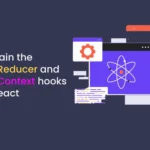Hooks are special functions in React that let you use state and other React features in functional components .two most commonly used hooks are:
useState()managing state .useEffect()side effects (e.g., data fetching, subscriptions, DOM updates) .
1. useState Hook: Purpose: The useState() hookadd state to a functional component .
Syntax: javascriptCopyEditconst [state, setState] = useState(initialValue);
Part Description stateCurrent state value .setState()Function to update the state .initialValueInitial value of the state .
Example: javascriptCopyEditimport { useState } from 'react';
function Counter() {
const [count, setCount] = useState(0);
return (
<div>
<p>Count: {count}</p>
<button onClick={() => setCount(count + 1)}>Increment</button>
</div>
);
}
Explanation:
useState(0)count state with 0.setCount(count + 1)triggers a re-render .
Key Points: Feature Description Re-renders Component Component re-renders when state changes .Preserves State State persists between renders . Can Store Any Value State can hold numbers, strings, objects, arrays, etc. Initial Value Can be a value or a function returning a value .
2. useEffect Hook: Purpose: The useEffect() hookperform side effects in functional components , such as:
Fetching data from an API.
Subscribing to events.
Updating the DOM.
Running code after every render or only when specific values change .
Syntax: javascriptCopyEdituseEffect(() => {
// Side effect code
return () => {
// Cleanup code (optional)
};
}, [dependencies]);
Part Description Callback Function The effect you want to run (e.g., fetching data).Dependencies Array List of values to watch for changes (optional).Cleanup Function Optional function to clean up resources (e.g., event listeners).
Example 1: Run on Every Render javascriptCopyEditimport { useState, useEffect } from 'react';
function Example() {
const [count, setCount] = useState(0);
useEffect(() => {
console.log(`Count is ${count}`);
});
return (
<div>
<p>Count: {count}</p>
<button onClick={() => setCount(count + 1)}>Increment</button>
</div>
);
}
No dependencies array → Runs on every render.
Example 2: Run Only Once (On Mount) javascriptCopyEdituseEffect(() => {
console.log('Component mounted');
}, []);
Empty dependencies array → Runs only once when the component mounts.
Example 3: Run When State/Props Change javascriptCopyEdituseEffect(() => {
console.log(`Count changed to ${count}`);
}, [count]);
Runs only when count changes.
Example 4: Cleanup Example javascriptCopyEdituseEffect(() => {
const timer = setInterval(() => {
console.log('Interval running');
}, 1000);
return () => {
clearInterval(timer);
console.log('Interval cleared');
};
}, []);
Cleanup function clears the interval when the component unmounts.
Key Points: Feature Description Side Effects Used for data fetching, subscriptions, DOM manipulation . Dependencies Controls when the effect runs .Cleanup Function Prevents memory leaks when adding event listeners or intervals .Runs After Render Effects run after every render by default .
Summary: Hook Purpose Example Use Case useStateManage component state Form inputs, counters, toggles useEffectHandle side effects Fetching data, event listeners, subscriptions
Comparison of useState vs useEffect: Hook State Management Side Effects useStateStores and updates data Does not handle side effects useEffectPerforms side effects Does not manage state directly
Let me know if you need help with examples or deeper explanations on Hooks or React concepts! 🚀😊






